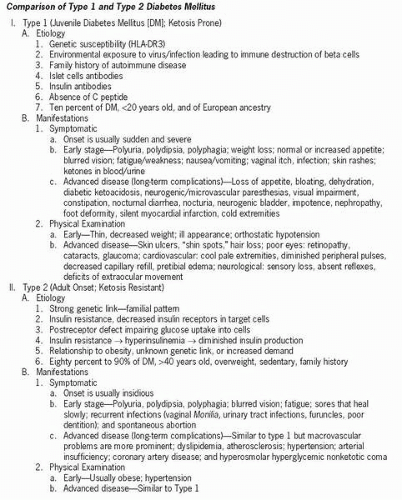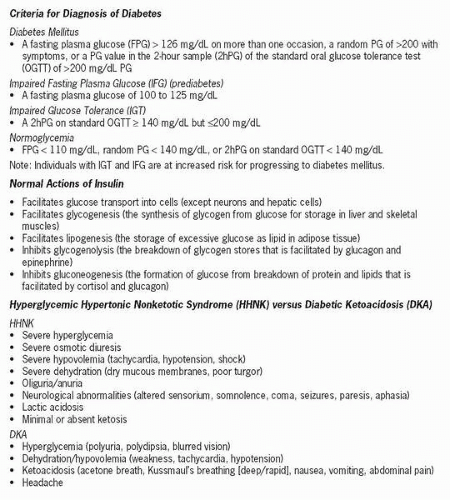Diabetes Mellitus
Diabetes mellitus (DM) is a group of heterogeneous disorders characterized by abnormalities in glucose homeostasis, resulting in chronic hyperglycemia. Hyperglycemia is caused by a decrease in the secretion or activity of insulin and destruction of pancreatic beta cells. This alteration in insulin results in disordered metabolism of carbohydrates, fats, and proteins, which may lead to acute, life-threatening complications or chronic complications, including vascular and neurological deficits.
Table 23-1 Risk Factors for Diabetes Mellitus | ||||||||||||||
|---|---|---|---|---|---|---|---|---|---|---|---|---|---|---|
| ||||||||||||||
Table 23-2 Screening Guidelines for Diabetes Mellitus | |||||
|---|---|---|---|---|---|
|
DM affects 16 million Americans (6%), with one-third undiagnosed. The number is expected to double in the next decade. African Americans, Hispanics, and Native Americans are particularly vulnerable to the disease and its complications. It is the seventh leading cause of death in the United States and is a significant contributing factor in deaths from other causes. Life expectancy is reduced by about 15 years, and quality of life is impacted. It is the leading cause of end-stage renal disease, blindness, and nontraumatic lower extremity amputations. Approximately 80% of diabetics have cardiovascular complications. The economic cost is estimated to be $102 billion per year.
 The American Diabetes Association identifies four types of DM: Type 1 (absolute insulin deficiency, ketosis prone), Type 2 (insulin resistant, nonketosis prone), gestational (glucose intolerance first recognized during pregnancy, usually the third trimester), and “other specific types” (due to gestational diabetes or less common secondary conditions such as pancreatic disorders, drug related).
The American Diabetes Association identifies four types of DM: Type 1 (absolute insulin deficiency, ketosis prone), Type 2 (insulin resistant, nonketosis prone), gestational (glucose intolerance first recognized during pregnancy, usually the third trimester), and “other specific types” (due to gestational diabetes or less common secondary conditions such as pancreatic disorders, drug related).The American Diabetes Association identifies four types of DM: Type 1 (absolute insulin deficiency, ketosis prone), Type 2 (insulin resistant, nonketosis prone), gestational (glucose intolerance first recognized
during pregnancy, usually the third trimester), and “other specific types” (due to gestational diabetes or less common secondary conditions such as pancreatic disorders, drug related).
during pregnancy, usually the third trimester), and “other specific types” (due to gestational diabetes or less common secondary conditions such as pancreatic disorders, drug related).
Stay updated, free articles. Join our Telegram channel

Full access? Get Clinical Tree




